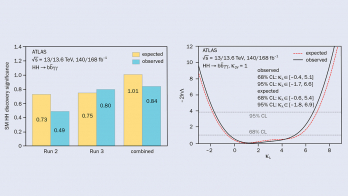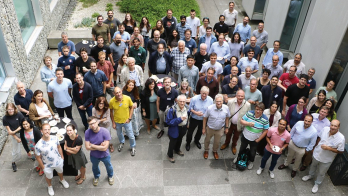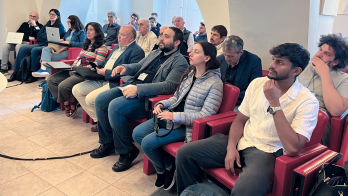Confirming the electroweak Standard Model drove three major projects at CERN spanning three decades, culminating in the discovery of the Higgs boson on 4 July 2012. Matthew Chalmers captures a glimpse of particle physics’ great adventure.
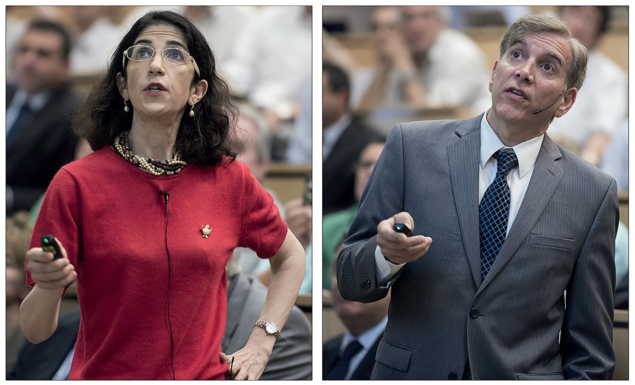
At around 10:30 a.m. on 4 July 2012, two remarkable feats of theoretical and experimental physics reached an apex in the CERN auditorium. One was the work of a few individuals using the most rudimentary of materials, the other a global endeavour involving thousands of people and the world’s most powerful collider. Forty-eight years after it was predicted, the CMS and ATLAS collaborations presented conclusive evidence for the existence of a new elementary particle, the Higgs boson, the cornerstone of the electroweak Standard Model.
“It took us several years to recover,” says CMS experimentalist Chiara Mariotti, who was co-convener of the collaboration’s Higgs group at the time. “For me there was a strong sense of ‘Higgs blues’ afterwards! On the other hand, the excitement was also productive. Immediately after the discovery we managed to invent a new method to measure the Higgs width, with a precision more than 200 times better than what we were thinking – a real breakthrough.”
Theoretically, the path to the Higgs boson had been paved by the early 1970s, building on foundations laid by the pioneers of quantum field theory and superconductivity. When Robert Brout and François Englert, and independently Peter Higgs, published their similarly titled papers on broken symmetry and the mass of gauge bosons in 1964, nobody took much notice. One of Higgs’s manuscripts was even rejected by an editor based at CERN. The profound consequences of the Brout–Englert–Higgs (BEH) mechanism – that the universe is pervaded by a scalar field responsible for breaking electroweak symmetry and giving elementary particles their mass (see “The Higgs, the universe and everything” panel) – only caught wider attention after further Nobel-calibre feats by Steven Weinberg, who incorporated the BEH mechanism into electroweak theory developed also by Abdus Salam and Sheldon Glashow, and by Gerard ’t Hooft and Martinus Veltman, who proved that the unified theory was mathematically consistent and capable of making testable predictions (see A triumph for theory).
Over to CERN
The first bridge linking the BEH mechanism to the real world was sketched out in CERN’s theory corridors in the form of a 50-page-long phenomenological profile of the Higgs boson by John Ellis, Mary Gaillard and Dimitri Nanopoulos published in 1976. The discovery of neutral currents in 1973 by Gargamelle at CERN, and of the charm quark at Brookhaven and SLAC in 1974, had confirmed that the Standard Model was on the right track. Despite their conviction that something like the Higgs boson had to exist, however, Ellis et al. ended their paper on a cautionary, somewhat tongue-in-cheek note: “We apologise to experimentalists for having no idea what is the mass of the Higgs boson… and for not being sure of its couplings to other particles, except that they are probably all very small. For these reasons we do not want to encourage big experimental searches for the Higgs boson, but we do feel that people performing experiments vulnerable to the Higgs boson should know how it may turn up”.
As it turned out, discovering and measuring the electroweak bosons would drive three major projects at CERN spanning three decades: the SPS proton–antiproton collider, LEP and the LHC. Following Carlo Rubbia and Simon van der Meer’s ingenious modification of the SPS to collide protons and antiprotons, greatly increasing the available energy, the UA1 and UA2 collaborations confirmed the existence of the W boson on 25 January 1983. The discovery of the slightly heavier Z boson came a few months later. The discoveries made the case for the Higgs boson stronger, since all three bosons hail from the same scalar field (see panel).
The Higgs, the universe and everything

The full SU(2) scalar doublet field φ has too many dimensions to draw. In this “U(1)” picture, there is only one degree of freedom (around the rim of the hat) that is absorbed by a gauge boson. In fact, the rim isn’t one-dimensional but three-dimensional, and the three components that are absorbed to generate masses for the W+, W– and Z bosons correspond to field displacements in that space. Results from the LHC so far suggest that the BEH potential turns over at a value of about 1012 GeV, with implications for the stability of the universe (see The Higgs and the fate of the universe). Credit: J Ellis/M Neubauer
The Higgs boson is the excitation of a featureless condensate that fills all space – a complex scalar field with a shape resembling a Mexican hat. The universe is pictured as being born in a symmetric state at the top of the hat: the electromagnetic and weak forces were one, and particles moved at the speed of light. A fraction of a nanosecond later, the universe transitioned to a less symmetric but more stable configuration in the rim of the hat, giving the universe a vacuum expectation value of 246 GeV.
During this electroweak symmetry- breaking process, three of the BEH field’s components were absorbed to generate polarisation states, and thus masses, for the W and Z bosons; the other component, corresponding to a degree of freedom “up and down” the rim of the hat, is the Higgs boson (see “Lifting the lid” image). The masses of the fermions are generated via Yukawa couplings to the BEH field, implying that mass is not an intrinsic property of elementary particles.
The roots of the BEH mechanism lie in the phenomenon of spontaneous symmetry breaking, which is inherent in superconductivity and superfluidity. In 1960, Yoichiro Nambu and then Jeffrey Goldstone introduced spontaneous symmetry breaking into particle physics, paving the way for taming the weak interaction using gauge theory, like electromagnetism before it. Four years later, Robert Brout and Franҫois Englert and, independently, Peter Higgs, showed that a mathematical obstacle called the Goldstone theorem, which implied the existence of unobserved massless particles, is a blessing rather than a curse for gauge theories: the degrees of freedom responsible for the troublesome massless states generate masses for the heavy gauge bosons that mediate the short-range weak interaction (see A triumph for theory).
LEP, along with the higher energy Tevatron collider at Fermilab, offered Higgs hunters their first serious chance of a sighting. Dedicated analysis groups formed in the experiments. For a decade they saw nothing. Then, on 14 June 2000, LEP’s final year of scheduled running, ALEPH reported a Higgs candidate at around 114–115 GeV, followed soon by a second and third event. LEP was granted a one-month extension. On 16 October, L3 announced a candidate. By 3 November ALEPH had notched up a 2.9σ excess. A request to extend LEP by one year was made, but there was deadlock at CERN. Five days later, Director-General Luciano Maiani announced that LEP had closed for the last time, so as not to delay the LHC. In addition to determining the properties of the W and Z bosons in detail and confirming the existence of electroweak radiative corrections, LEP had planted a flag in energy below which the Higgs would not be found.
Muscling a discovery
In 1977, CERN Director-General John Adams had the foresight to make the LEP tunnel large enough to accommodate a TeV hadron collider capable of probing the scale of electroweak symmetry breaking. Spurred on by the W and Z discoveries, finding or ruling out the Higgs boson became the central goal of the LHC, greatly influencing the designs of the ATLAS and CMS detectors during the 1990s. Tens of millions of people worldwide watched as the first proton beams were threaded through the machine on 10 September 2008. While the LHC had other goals, the quest for the Higgs boson and the origin of mass resonated with non-experts and brought particle physics to the world.
It was a bumpy start (see The bumpy ride to the bump), but high-energy LHC data began to flood in on 10 March 2010. By the time of the European Physical Society high-energy physics conference in Grenoble in July 2011, ATLAS and CMS were ready to offer a peek of their results. Practically, the search for the Higgs came down to a process of excluding mass ranges in which no signal had been seen. ATLAS and CMS had shrunk the allowed range and found a number of events hinting at a Higgs boson with a mass of about 142 GeV. “We both saw a bump at the same place, and we had champagne after the talks,” recalls Kyle Cranmer, co-coordinator of the ATLAS Higgs combination group at the time. “We weren’t confident then, but we were optimistic.” Fermilab’s Tevatron collider was also sensitive to a Higgs in the upper mass range and its CDF and D0 experiments pioneered many of the analysis methods that were used in ATLAS and CMS. Just four years earlier, they had hinted at a possible signal at 160 GeV, only for it to disappear with further data. Was the US machine about to make a last-gasp discovery and scoop the LHC?
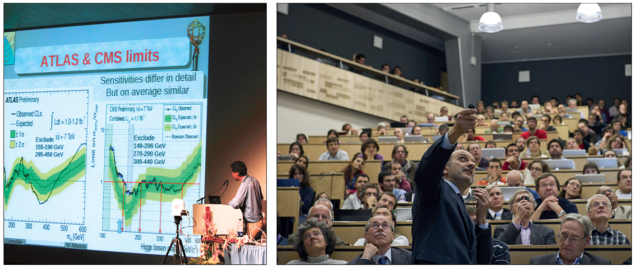
The media were hot on the sigma trail. On 13 December 2011, the LHC experiments updated their findings: ATLAS constrained the Higgs to lie in the range 116-130 GeV, and CMS to lie in the range 115-127 GeV. For some, a light Higgs boson was in the bag. Others were hesitant. “There was a three-sigma excess when combining all the channels, but there were also less significant excesses in other mass regions,” recalls Mariotti. “I maybe also wanted not to believe it, in order not to be biased when analysing the data in 2012. And maybe because somehow if the Higgs was not there, it would have been really thrilling, much more challenging for us all.”
The following year, with the LHC running at a slightly higher energy, the collaborations knew that they would soon be able to say something definitive about the low-mass excess of events. From that moment, CMS decided not to look at the data and instead to redesign its analyses on simulated events “blinded”. On the evening of 14 June, all the analysis groups met separately to “open the box”. The next day, they shared their results with the collaboration. The two-photon and four-lepton channels had a beautiful peak at the same place. “It was like a very strong punch in the stomach,” says Mariotti. “From that moment it was difficult to sleep, and it was hard not to smile!”
The quest for the Higgs boson and the origin of mass resonated with non-experts and brought particle physics to the world
Members of both collaborations were under strict internal embargoes concerning the details. ATLAS unblinded its di-photon results late on 31 May, revealing a roughly 2σ excess. By 19 June it had grown to 3.3σ. The four-lepton group saw a similar excess. “My student Sven Kreiss was the first person in ATLAS to combine the channels and see the curve cross the 5σ threshold,” says Cranmer. “That was on 24 June, and it started to sink in that we had really found it. But it was still not clear what we would claim or how we would phrase things.” Amazingly, he says, he was not aware of the CMS results. “I was also not going out of my way to find out. I was relishing the moment, the excitement, and the last days of uncertainty. I also had more important things to do in preparation for the talk.”
With the rumour mill in overdrive, a seminar at CERN was called for 4 July, also the first day of the ICHEP conference in Melbourne. Peter Higgs and François Englert, and Carl Hagan and Gerald Guralnik (who, with Tom Kibble, also arrived at the mass-generating mechanism), were to be there. The collaborations were focused only on their presentations. It had to be a masterpiece, says Mariotti. The day before, the CMS and ATLAS Higgs conveners met for coffee. They revealed nothing. “It was really hard not to know. We knew we had it, but somehow if ATLAS did not have it or had it but at a different mass, it all would have been a big disillusion.”

Many at CERN decided to spend the night of 3 July in front of the auditorium so as not to miss the historic moment. CMS spokesperson Joe Incandela was first to guide the audience through the checks and balances behind the final plots. Fabiola Gianotti followed for ATLAS. When it was clear that both had seen a 5σ excess of events at around 125 GeV, the room erupted. Was is it really the Higgs? All that was certain was that the particle was a boson, with a mass where the Standard Model expected it. Seizing the moment, and the microphone, Director-General Rolf Heuer announced: “As a layman, I would now say ‘I think we have it’, do you agree?” It was a spontaneous decision, he says. “For a short period between the unblindings and the seminar, I was one of the few people in the world, just with research director Sergio Bertolucci, in fact, who was aware of both results. We would not have announced a discovery had one experiment not come close to that threshold.”
The summer of 2012 produced innumerable fantastic memories, says Marumi Kado, ATLAS Higgs-group co-convener at the time and now a deputy spokesperson. “The working spirit in the group was exceptional. Each unblinding, each combination of the channels was an incredible event. Of course, the 4 July seminar was among the greatest.” In CMS, says Mariotti, there was a “party-mood” for months. “Every person thought, correctly, that they had played a role in the discovery, which is important, otherwise very large experiments cannot be done.”
The path from here
Ten years later, ATLAS and CMS measurements have shown the Higgs boson to be consistent with the minimal version required by the Standard Model. Its couplings to the gauge bosons and the heaviest three fermions (top, bottom and tau) have been confirmed, evidence that it couples to a second-generation fermion (the muon) obtained, and first studies of Higgs–charm and Higgs–Higgs couplings reported (see The Higgs boson under the microscope). However, data from Run 3, the High-Luminosity LHC and a possible Higgs-factory to follow the LHC, are needed to fully test the Standard-Model BEH mechanism (see The Higgs after LHC).
Every person thought, correctly, that they had played a role in the discovery, which is important, otherwise very large experiments cannot be done
Events on 4 July 2012 brought one scientific adventure to a close, but opened another, fascinating chapter in particle physics with fewer theoretical signposts. What is clear is that precision measurements of the Higgs boson open a new window to explore several pressing mysteries. The field from which the Higgs boson hails governs a critical phase transition that might be linked to the cosmic matter–antimatter asymmetry (see Electroweak baryogenesis); as an elementary scalar, it offers a unique “portal” to dark or hidden sectors which might include dark matter (see Through the Higgs portal); as the arbiter of mass, it could hold clues to the puzzling hierarchy of fermion masses (see The origin of particle masses); and its interactions govern the ultimate stability of the universe (see The Higgs and the fate of the universe). The very existence of a light Higgs boson in the absence of new particles to stabilise its mass is paradoxical (see Naturalness after the Higgs). Like the discovery of the accelerating universe, Nima Arkani-Hamed told the Courier in 2019, it is profoundly “new” physics: “Both discoveries are easily accommodated in our equations, but theoretical attempts to compute the vacuum energy and the scale of the Higgs mass pose gigantic, and perhaps interrelated, theoretical challenges. While we continue to scratch our heads as theorists, the most important path forward for experimentalists is completely clear: measure the hell out of these crazy phenomena!”






